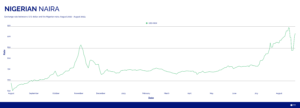Africa Currencies Topline
Nigeria: Labor union spurs the Nigerian central bank to action.
Ghana: Price increases in the dollar and petroleum products.
South Africa: Rand continues trading to the beat of external factors.
Egypt: Greater exchange rate flexibility continues to impact foreign exchange reserves.
Kenya: Central bank retains the CBR rate at 10.5%.
Uganda: Uganda cuts interest rates by 50bps.
Tanzania: Export earnings go up thanks to minerals.
XOF Regions: SONASP created to improve gold mining profits.
XAF Region: Cameroon to optimize the collection of nontax revenues.
Nigerian Naira (₦)
Compiled by Ikenga Kalu
The naira clawed back some gains against the U.S. dollar, climbing from USD/NGN 930 recorded last week to USD/NGN 910 this week.
Petrol marketers have cited their inability to source forex at the Central Bank of Nigeria (CBN) window as the basis for possibly hiking the price of fuel. As a result, the marketers have halted fuel importation because sourcing forex at the substantially higher parallel market rate would make it prohibitive to sell at the government mandated pump price. The Nigeria Labour Congress threatened to go on strike following hints by petrol marketers that the pump price of fuel might spike to 720 NGN/liter should the naira continue its wild depreciation. In response, the office of the presidency issued a statement saying it did not expect any further petrol price hike, which essentially calls into question the subsidy removal.
The acting governor of the central bank has vowed to introduce measures to clamp down on currency speculators in the bid to afford some respite to the falling naira. This prompted a two-day trend reversal which reportedly pushed some offers into the mid USD/NGN 890 levels. However, questions have been raised regarding the sustainability of this new naira rally.
We expect further appreciation of the naira in the coming days. We may see some profit-taking as the parallel market rate gets close enough to the official market rate, which may curtail the appreciation.
Further reading:
Punch — NLC protests proposed fuel price hike, threatens fresh strike
The Nation — Marketers stall petrol importation over forex unavailability
ThisDay — Subsidy is Gone! Long Live Fuel Subsidy

Ghanaian Cedi (GH¢)
Compiled by Sakina Seidu
The U.S. dollar bounced back against the cedi as market levels moved from USD/GHS 11.2 to 11.375 at the close of the week with corporate institutions’ requests for forex increasing.
This comes on the back of the increase of cost of goods and services shown in the inflation rise for July 2023. Also, the Chamber of Petroleum Consumers (COPEC), has sounded an alert on the impending increase in petrol, diesel and liquefied petroleum gas (LPG) in the coming days. COPEC estimated increases of 5% for petrol/diesel and 11% for LPG.
We can expect these costs to go higher and a continued depreciation in GHS given the increase in the dollar.
Further reading:
Inflation outlook for August 2023 could prompt further policy action
Petrol to sell at GHS 12.97, diesel GHS 13.43 per liter – COPEC
Petrol prices: Why are they going back up?

South African Rand (R)
Compiled by Alex Barmuta
The South African rand started the new week at USD/ZAR 18.9471, before crossing back above the 19 level as of Wednesday afternoon.
The rand continues to be heavily influenced by external factors , as a stronger dollar, combined with ongoing concerns about the Chinese economy, continue to weigh on the rand.
Domestically, signs of easing on rotational power cuts have seen some analysts forecast major gains for the rand in Q1 2024
Looking at the week ahead, we can expect the rand to continue trading close to 19 against the dollar. Daily resistance is expected around 19.20 to the upside, and support around 18.90.
Further reading:
Bloomberg — Rand Seen Getting a Boost From Better South African Power Supply

Egyptian Pound (EGP)
Compiled by Mitchell Diedrick
The Egyptian pound crossed over the psychological resistance level of USD/EGP 31 this week to trade at USD/EGP 31.07 on Monday before retreating to 30.95 against the dollar.
A more flexible pound has been a topic of many discussions especially relating to the International Monetary Fund (IMF) deal that was granted toward the end of last year. The presidency has stated that while it is open to a more flexible exchange rate regime, it needs to protect the citizens. IMF Managing Director Kristalina Georgieva, has said that the IMF is engaged in positive talks with the Egyptian government and will lean on expertise to assist the Egyptian government with further privatization of the economy.
Furthermore, they believe that the Egyptian government can assist in reforming the economy by reducing involvement in economic activities, enhancing subsidies to the most vulnerable citizens and investigating opportunities to improve Egypt’s foreign exchange reserves.
Further reading:
Egypt today – Egypt’s economy and IMF agreement amid exchange rate uncertainty

Kenyan Shilling (KSh)
Compiled by Terry Karanja
The Kenyan shilling is trading between USD/KES 143.70/144.10 which is a drop from 143.20/143.50 the previous week. The Central Bank of Kenya has left its benchmark lending rate unchanged at 10.5% after noting that the inflation pressures had eased. The Monetary Policy Committee noted that inflation is already within the target band of 2.5% to 7.5%. It was at 7.3% in July and is anticipated to decline further as food inflation is expected to come down. The Committee also noted that inflationary pressures had eased as non-food, non-fuel inflation declined. The impact of the tightening of monetary policy in June 2023 to anchor inflationary expectations was still transmitting in the economy thus retaining the CBR rate. The usable foreign exchange reserves remained adequate at USD 7,357 million which is 4.02 months of import cover that meets the CBK’s statutory requirement to maintain at least four months. We expect to see more pressure on the shilling with increased forex demand.
Further reading:
BusinessDaily – CBK holds the benchmark lending rate on inflation ease
Ugandan Shilling (USh)
Compiled by Yadhav Panday
USD/UGX traded at 3,727 on Wednesday, Aug. 16, 2023, up 0.19% from last Friday. Looking ahead, we expect USD/UGX to weaken as a result of the Bank of Uganda deciding to reduce its benchmark interest rate to 9.5% from 10%. The move — an effort to stimulate economic activity after inflation fell below its target — came during its meeting on Aug. 15. Uganda’s annual inflation rate fell for the sixth consecutive month in July 2023, to 3.9%, from 4.9% in June; the lowest level since March 2022.
Further reading:
Bloomberg – Uganda Cuts Rates, Vows to Act if World Bank LGBTQ Move Hits FX

Tanzanian Shilling (TSh)
Compiled by Kristin Van HelsdingenThe Tanzanian shilling weakened to USD/TZS 2,505 last week Thursday. This is the weakest level for the shilling against the U.S. dollar since 2017. It has continued trading around this level and is currently at USD/TZS 2,502. With the shilling nearing its all-time weakest level against the dollar, we expect this to have a knock-on effect as the cost of importing increases the price of products ultimately causing rising inflation.
Data released by the Bank of Tanzania showed that non-traditional exports grew by 4.2% in June, year-on-year. The increase was mainly driven by minerals. The total USD value in exports for this period was $12,767.6 million.
Looking at the week ahead, we can expect the shilling to weaken to around the USD/TZS 2,510 level, as the uptick in dollar strength will likely keep the shilling under pressure.
Further reading:
Daily news — Minerals, services receipts drive up export earnings
| Final graph/chart image from Infogram here (pulls from this data). |
West African CFA Franc Region (XOF)
Compiled by Yashveer Singh
Burkina Faso established the national Society of Precious Substances (SONASP) on Aug. 9, 2023, aiming to enhance profits from gold mining and to promote responsible, sustainable mining practices. This new state-owned company replaces the previous national agency responsible for supervising artisanal and semi-mechanized mining operations. The previous agency, ANEEMAS, was formed in 2015 to oversee gold mining, minimize environmental impacts, improve safety, prevent fraud, and eliminate child labor in the sector. The new company, SONASP, holds expanded responsibilities, including processing, marketing, and mechanization of mining products.
Specific details of the recent amendments to the mining code made in April 2023 are yet to be disclosed. They are likely to follow a similar path as neighboring Mali, which seeks to increase the mining sector’s contribution to the economy. Mali adopted a new mining code this month, enabling the government to hold up to 35% interest in mining projects, up from the previous limit of 20% in the 2019 code.
Further reading:
Sikafinance with Burkina: The government creates a company to better profit from mining
Central African CFA Franc Region (XAF)
Compiled by Yashveer Singh
Finance Minister Louis Paul Motaze led a workshop in Bangou, Cameroon, on Aug. 7, 2023, to promote Tresor Pay, a platform designed to collect nontax revenues, including fines, rents, fees, and more. The government has struggled to manage these revenues, collecting CFAF 160 billion in 2021 against a target of CFAF 187.4 billion. The 2023 budget aims for CFAF 250.4 billion from nontax revenues out of an estimated CFAF 800 billion. Tresor Pay seeks to optimize collection to meet this potential, four times the 2023 target.
The Ministry of Finance has prioritized improving nontax revenue collection due to declining internal revenues and rising state expenses, driven by security, debt, and development spending. The outlook for 2024 remains challenging, according to the ministry.
Further reading:
Business in Cameroon — Cameroon launches platform to optimize the collection of non-tax revenues
| Final graph/chart image from Infogram here (pulls from this data). |











